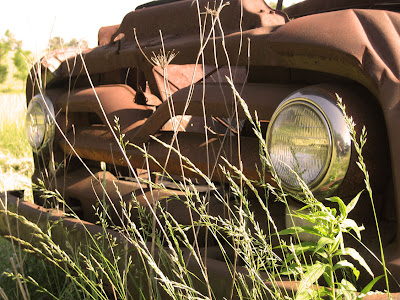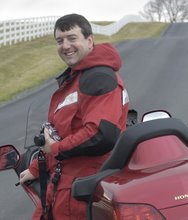In The Essential Guide to Motorcycle Travel (EGMT), I wrote extensively about GPS navigation systems, which is a little like writing about my daughter's current favorite teen star. Chancy business. In certain categories like electronics, print titles are always playing catch up to the latest and greatest. Just like dads.
The theory of GPS operation is still the same, which is the bulk of the chapter. However since EG was published, the Garmin Zumo has replaced the Garmin StreetPilot 2830 as one of the premiere motorcycle GPS systems on the market. I've been using a Zumo for almost a year now and thought I'd offer a few comments to supplement what was said in the book. Others, like Motorcycle Consumer News, have offered far more comprehensive reviews. These thoughts comprise my $.02.
I was immediately attracted to the idea that the Zumo was offered in a kit that includes all the accessories most riders would need to bolt the unit on their bike and go exploring, today. In the past, the biggest obstacle to putting a GPS on your bike was figuring out all the OTHER stuff you needed. The Zumo 550 also includes the gear you'd need to use the system in a four-wheeler, which I do as much as the bike. Very handy.
Voice prompting has been standard on automotive GPS systems for some time, i.e. "In 500 feet, turn left." Text-to-speech systems improve on that by announcing the exact street name to turn onto. "In 500 feet, turn left on Progress Street." This is a small refinement but an important safety feature for motorcyclists. When hearing the old prompts, you'd have to look at the screen to see the street name. With text-to-speech systems, you don't need to look at all.
If you're stepping up from an older StreetPilot like the 2610 (my first), you will appreciate the improved navigation and predictive spelling. When entering a city name, the GPS will return a short list as soon as you've entered enough of the name. Often it will return a list of two or three names with just a few characters entered.
I was really pleased to find integration with XM radio on the Zumo. I'm a big satellite radio fan. I just love being able to listen to the radio without fishing around for a new station every 50 miles. Of course, you have to purchase the Garmin GXM-30 antenna, which is about the size of a hockey puck and not cheap. I couldn't imagine why an antenna was so expensive, but later learned that it also contains the radio's electronics.
Bluetooth integration is nice, and I've used it a few times, but only in the car, not on the bike. Let's say you're hummin' along I-74 through Peoria and are getting toward the end of the riding day. You look up hotels ahead and find a list in Davenport, Iowa about an hour and a half ahead. With a Bluetooth connection to your phone, a "Dial" button becomes available that allows you to dial the number associated with a listing without entering the number. Likewise, in the car, the car adaptor includes a mic and speaker, so your Zumo acts as both a call manager and hands-free phone kit. Not essential, but a nice plus.
Those are the things I like. There are a few things I don't, to wit:
List priority is a mystery to me. For example, I'll often make changes en route (Safely off the road. Please!) and some times use the "Spell" feature to return a list of whatever I'm looking for, e.g., a restaurant, a city, etc. I'd like to see the list in order of distances from me. If I'm looking up, oh let's say "Lexington," I'd like to see Lexingtons from nearest, at the top of the list, to furthest. Instead, the one I want is always at the bottom of the list. Maybe there's a way to change this? If so, I'd like to know.
I wish Garmin would license a mapping product from someone like DeLorme or even Microsoft. Mapsource, the route mapping software that comes with every Garmin, feels software thrown together by a committee of Dilberts after a three-martini lunch. No offense to anyone actually name "Dilbert" -- you've suffered enough injustice already. And I can't say DeLorme is entirely without fault. Their Street Atlas product could use some updating too -- the tabbed mess at the bottom of the screen is a prime example.
The Zumo motorcycle mount needs to be beefed up and a better way should be devised to allow you to lock/unlock the unit. Would you like having to a) keep track of and b) fish out a tiny, specially-designed screwdriver to unlock your GPS every time you walk away from the bike for more than a minute? No. Do you have to? If your Zumo is wired for power to your bike, yes. There is no way that the little plastic mount, locked or unlocked, would stand up to even a semi-determined thief for more than 30 seconds. Unless you want to chance it and leave your expensive gizmo alone in the parking lot while you grab some lunch. Didn't think so. That means the only alternative is to take out the special pronged screwdriver (better keep it in a handy place), and loosen the screw that locks the release, stow the GPS, then reattach and re-screw, er, re-tighten the locking screw. Rather than this arrangement I'd like to see some type of spring-loaded button lock that engages when the GPS is mounted, then you'd have to actively push the button to release the unit.
On Bluetooth-equipped Zumos (the 550), you can pair the Zumo with a Bluetooth headset in your helmet, enabling you to hear voice prompts or audio from the MP3 player. Great. However, the Bluetooth connection does not support XM radio audio. If you want XM audio, that is only available through a headphone output. Maybe this has been addressed since I bought mine. Given the increasing popularity of Bluetooth, I'm sure it's just a matter of time. Still, I don't see why that couldn't have been available at the outset.
The Zumo doesn't support multiple waypoints when you're programming it on the fly. I can live with that. It doesn't offer touchscreen map movement. I can live with that, too, although I spent a good ten minutes on my first use trying to do so. Turns out, if you navigate down a couple of screens away from the main map, you can in fact move the map around with your finger, but it isn't obvious and I don't find it as useful as being able to do so at a higher level.
Yeah, I know, pick, pick, pick. None of these things is a big deal, however, the biggest fault with the Zumo, its fragile nature, cannot be so easily explained away. No one knows what percentage of Zumos have failed within a year, but if traffic on various motorcycle and Zumo related forums are any indication, it's higher than normal. At one time, I sold Zumos through my shop (no more -- can't keep up with the falling prices), and fully half of them required a warranty repair or replacement, including mine. Out of the box, mine never charged the battery. A replacement battery was issued. Later, the whole unit would simply shut off or reset itself. The replacement battery didn't fix the charging problem, so the whole unit was replaced. The headphone output jack in the car adaptor snapped off the printed circuit board. I have no fault with Garmin's response to my service requirements. There was never any hassle and they replaced everything in a timely manner. But still, it'd be nice to avoid these problems to begin with.
What it all comes down to is this -- given what I know now, would I buy another Zumo? I'd have to say "yes, I would." If I were a new GPS buyer, some of the interface issues I have would never have been apparent to me. Evidence with respect to the Zumo's fragile nature is purely anecdotal and Garmin's response, at least to my issues, have been satisfactory.
No, I have to say that despite the issues, I wouldn't give up my Zumo and I wouldn't trade back down to a StreetPilot. I would, however, like very much to get my XM audio via Bluetooth. I could forgive its other shortcomings if I could just get my Miles Davis and Steely Dan floating beamed directly to my headset, sans wires.






